Resources
 Part of the Oxford Instruments Group
Part of the Oxford Instruments Group
Expand
Collapse
 Part of the Oxford Instruments Group
Part of the Oxford Instruments Group
There are a number of techniques used to manipulate the readout of CCDs to achieve various effects. One of these techniques is ‘binning’. For sCMOS based cameras, such as the Andor Neo and ZL41 Wave models, the binning process differs from that of CCD’s due to the technical differences between the two sensor technologies. This technical note outlines the use of binning for sCMOS and the effect of frame rates on different Neo and ZL41 Wave sCMOS camera models at different resolutions. Binning for CCD camera models is explained in the Andor Technical Note Pixel Binning in CCD Cameras
(Note that the Neo camera has been discontinued in June 2023.)
Binning is the procedure of combining the signal from a number of adjacent pixels into an output for a single pixel (super-pixel). For 2x2 binning, an array of 4 pixels becomes a single larger pixel, reducing the overall number of pixels that need to be readout and also reducing the resolution available. By combining the charge from 4 pixels into one super-pixel, the number of read events is reduced, therefore resulting in a lower read noise. Consequently, it is possible to use binning to increase the signal to noise ratio at the expense of lower resolution.
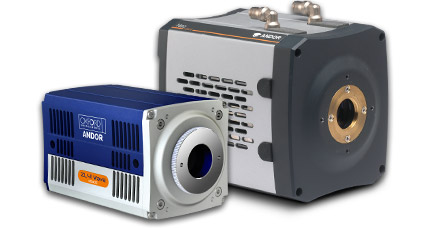
Figure 1: Andor ZL41 Wave and Neo sCMOS Cameras
In general, when binning is performed for CCD’s, fewer pixels are read-out so the acquisition speed can be increased. This provides benefits when a higher frame rate is desirable and the reduced resolution is not so critical.
Although the binning process is different to that of CCDs, binning in the Neo and ZL41 Wave sCMOS (Figure 1) also enables significant increases in frame rates. In the Andor Neo and ZL41 Wave sCMOS cameras, binning is performed in the FPGA after the image is read out from the sensor. Therefore, applying binning makes no difference to the number of pixels that are read-out from the sensor. Binning is performed after all other processing takes place and the binned image is then transmitted over the Camera-Link or USB 3.0 interface to the PC. The frame rates which can be achieved from the sensor are unaffected- but binning may enable higher frame rate transmission to PC.
It is important to note that the bit-depth does not scale with binning, 12-bit images will saturate at 4095 counts while 16- bit images will saturate at 65,000 whether binning is applied or not.
Binning in the Neo 5.5 and ZL41 Wave 5.5 USB 3.0 and ZL41 Wave 4.2 USB 3.0 can have a significant effect on frame rates since the sensor read-off is the limiting factor and not the FPGA processing. This is illustrated in the following figures for Neo 5.5, Zl41 Wave 4.2 and ZL41 Wave 5.5 USB 3.0. This increase in speed with binning does not apply to the ZL41 Wave 5.5 or ZL41 Wave 4.2 10-tap since the maximum speeds are already being achieved with the 10-tap Camera Link interface; however there is a slight increase in acquisition speeds when using the 16-bit mode in ZL41 Wave 5.5 10-tap.
Neo 5.5
RS= Rolling Shutter Mode, GS= Global Shutter Mode
12-bit (left), 16-bit (right)
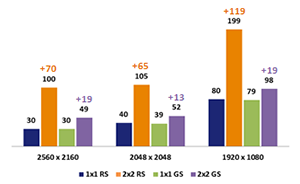
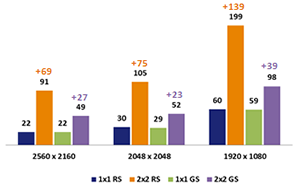
Figure 2: The effect of binning on the frame rate of Neo 5.5 at 12-bit (left) and 16-bit (right)
ZL41 Wave 4.2 USB 3.0
RS= Rolling Shutter Mode, GS= Global Shutter Mode
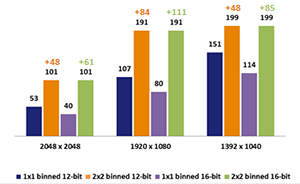
Figure 3: The effect of binning on the frame rates of the ZL41 Wave 4.2 at 12-bit (left) and 16-bit (right).
ZL41 Wave 5.5 USB 3.0
RS= Rolling Shutter Mode, GS= Global Shutter Mode
12-bit (left), 16-bit (right)
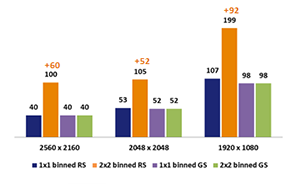
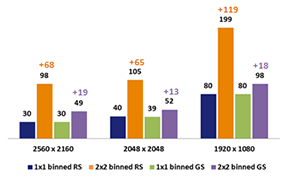
Figure 4: The effect of binning on the frame rates of the ZL41 Wave 5.5 at 12-bit (left) and 16-bit (right).
ZL41 Wave 5.5 Camera Link
RS= Rolling Shutter Mode, GS= Global Shutter Mode
12-bit (left), 16-bit (right)
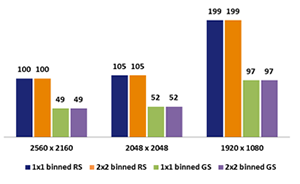
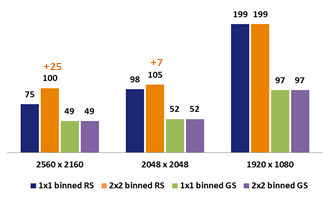
Figure 5: The effect of binning on the frame rates of the ZL41 Wave 5.5 Camera Link at 12-bit (left) and 16-bit (right).
The binning process on sCMOS sensors differs from that of CCD’s, but as with CCDs binning may also be utilised to provide increased frames rates. In this technical note, the effects of binning on the frame rates achievable with the Neo, ZL41 Wave Camera Link and USB 3.0 models have been outlined- showing that in some cases the frame rates can be significantly increased. For more information on the Neo and Zl41 Wave sCMOS cameras please go to the following link: https://andor.oxinst.com/products/scmos-camera-series/
Data Tables for Andor sCMOS Neo and ZL41 Wave models showing the framerates (fps) attainable under different modes
Neo 5.5
| 12-bit | 16-bit | |||||||
| Rolling Shutter | Global Shutter | Rolling Shutter | Global Shutter | |||||
| 1 x 1 | 2 x 2 | 1 x 1 | 2 x 2 | 1 x 1 | 2 x 2 | 1 x 1 | 2 x 2 | |
| 1920 x 1080 | 80 | 199 (+119) | 79 | 98 (+19) | 60 | 199 (+139) | 59 | 98 (+39) |
| 2048 x 2048 | 40 | 105 (+65) | 39 | 52 (+13) | 30 | 105 (+75) | 29 | 52 (+23) |
| 2560 x 2160 | 30 | 100 (+70) | 30 | 49 (+19) | 22 | 91 (+69) | 22 | 49 (+27) |
ZL41 Wave 4.2 USB 3.0
| 12-bit | 16-bit | |||
| Rolling Shutter | Rolling Shutter | |||
| 1 x 1 | 2 x 2 | 1 x 1 | 2 x 2 | |
| 1392 x 1040 | 151 | 199 (+48) | 114 | 199 (+85) |
| 1920 x 1080 | 107 | 191 (+88) | 80 | 191 (+111) |
| 2048 x 2048 | 53 | 101 (+48) | 40 | 101 (+61) |
ZL41 Wave 5.5 USB 3.0
| 12-bit | 16-bit | |||||||
| Rolling Shutter | Global Shutter | Rolling Shutter | Global Shutter | |||||
| 1 x 1 | 2 x 2 | 1 x 1 | 2 x 2 | 1 x 1 | 2 x 2 | 1 x 1 | 2 x 2 | |
| 1920 x 1080 | 107 | 199 (+92) | 98 | 98 | 80 | 199 (+111) | 80 | 98 (+18) |
| 2048 x 2048 | 53 | 105 (+52) | 52 | 52 | 40 | 105 (+65) | 39 | 52 (+13) |
| 2560 x 2160 | 40 | 100 (+60) | 40 | 40 (+19) | 30 | 98 (+68) | 30 | 49 (+19) |
ZL41 Wave 5.5 Camera Link
| 12-bit | 16-bit | |||||||
| Rolling Shutter | Global Shutter | Rolling Shutter | Global Shutter | |||||
| 1 x 1 | 2 x 2 | 1 x 1 | 2 x 2 | 1 x 1 | 2 x 2 | 1 x 1 | 2 x 2 | |
| 1920 x 1080 | 199 | 199 | 199 | 199 | 97 | 97 | 97 | 97 |
| 2048 x 2048 | 105 | 105 | 98 | 105 (+7) | 52 | 52 | 52 | 52 |
| 2560 x 2160 | 100 | 100 | 75 | 100 (+25) | 49 | 49 | 49 | 49 |
